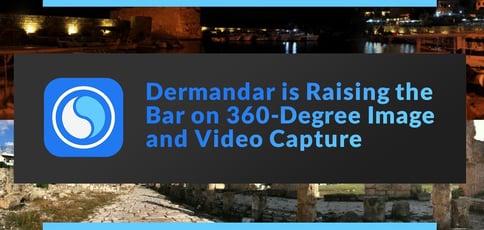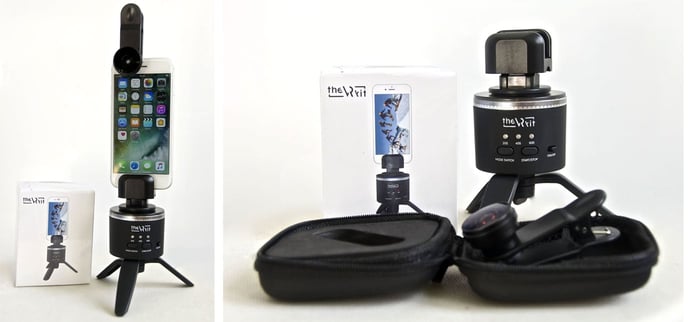
TL; DR: Dermandar, creator of the award-winning DMD Panorama app, uses its expertise in digital image and video stitching to create capture systems hosted in a specialized cloud. The company is also making waves in the virtual reality space via hardware such as theVRkit, a solution for turning any phone into a VR camera, and StereoStitch, a real-time 3D video stitching solution. Dermandar’s ultimate goal is to continuously pioneer 360-degree technologies for the rapidly changing retail, robotics, and real estate sectors, among other industries.
Many iPhone fanatics were delighted when Apple introduced built-in panoramic capture with the release of iOS 6 in 2012. But the technology wasn’t particularly new or unique to Apple. Dermandar, for example, has been pioneering 360-degree image stitching since the company’s founding in 2010.

Dermandar is the force behind DMD Panorama.
“Before you could access built-in panoramic features through your smartphone’s camera app, we had introduced DMD Panorama, an app designed for easy capture of 360 images on iPhone 3GS at the time,” said Elie Khoury, Founder and CEO of Dermandar. “We’ve been focused on 360-degree image stitching for the past decade, and we’ve been working to improve the user experience along the way.”
Dermandar’s diligence has given the company an edge in the 360-degree imaging and video capture space. Consumers have downloaded DMD Panorama more than 10 million times on iOS and Android, with iPhone users continuing to use the technology even after Apple introduced its built-in functionality.
Take this 2017 App Store review, for example: “I like it way better than Apple’s pano. The playback is very smooth, even with my shaky hands.” Or consider this one from 2013: “I find this app to be better than the native iPhone panorama feature and the built-in 3D viewer is awesome. I love that you can upload anonymously and share the images with a couple of clicks.”
Today, Dermandar continues to specialize in digital image and video stitching through the development of optimized processing algorithms that make for fast, reliable, and user-friendly products. The company is also trailblazing the virtual reality market via products such as theVRkit and StereoStitch.
Adapting to Hardware Changes in the Digital Imaging Space
Although the company was officially launched in 2010, Dermandar’s story dates back to 2008, when Elie was looking for a way to efficiently map spaces.
“The goal was to achieve the easiest 360-degree capture,” he said. “We actually started with a web solution. People could just plug in their digital camera and copy the images to the site. We used a Flash small application for stitching (now obsolete because Adobe has stopped supporting Flash Player). Then, in 2011, we jumped on the mobile train.”
Since then, Dermandar has produced a range of accessories designed to complement smartphones and capture tricky areas like ceilings and floors.
“We have developed a fisheye lens that you clip on the phone, which allows you to capture everything, including top and bottom, just by rotating it a single turn,” Elie said. “We also made small mechanical electronic rotators that spin to automate the system.”
As for the software itself, the latest version of DMD Panorama is a fully automated capture system that allows users to create and share panoramic images through email and on Facebook and Twitter, among other channels.
Features include lightning-fast stitching, an immersive 3D viewer with zoom and autoplay, three exposure settings, and the ability to edit descriptions, tags, geolocations, and privacy settings. Developers can purchase licensing packages for software development kits (SDKs) that facilitate app creation.
Elie told us that, over the years, Dermandar’s success resulted from the company’s ability to adapt to evolving mobile hardware and software — a trend that will continue as we move into the future. For example, the upcoming iPhone 12 Pro will feature a black dot at the bottom right of the camera known as a light detection and ranging (lidar) sensor. The depth-sensing technology has implications for augmented reality. Dermandar is keeping the technology top of mind.
“What was not possible with a simple camera is now possible with the lidar camera, because we’re able to capture not only the images but also 3D representations,” he said. “We can do things that we thought possible five years ago, and that’s why we’re always running to stay ahead of the curve. We always want to have that secret sauce.”
Solutions for Retail, Robotics, and Real Estate
Elie said that Dermandar focuses heavily on the real estate market. Realtors depend on cloud-hosted image processing technology to capture properties with the detail and precision offered by panoramic photography and video. With today’s social distancing mandates, they’re turning to virtual tours to market homes more than ever before.
Dermandar’s spherical capture solution, theVRkit, makes it easy for real estate agents or anyone with an interest in the technology to photograph every bit of the world around them. The hardware turns any smartphone into a 360-degree camera that captures multiple images and stitches them together. No internet connection is required.
The kit includes a rotator that uses Bluetooth to spin the phone in various directions and a high-quality, 180-degree fisheye lens that clips on to the phone. It is compatible with all iPhones and most Android models. It also includes a free app that produces industry-standard equirectangular images.
“It will transform your phone into an affordable 360 camera,” Elie said. “At around $100, it’s the least expensive solution for producing high-resolution walkthroughs. You don’t need to spend money on anything else. The results are amazing.”

theVRkit is a solution for turning any phone into a VR camera that comes complete with a free app.
Dermandar is also beta testing StereoStitch, a video stitching solution that processes 360 videos in real time.
“StereoStitch is a solution for VR cameras where you have multiple lenses pointed in every direction,” Elie said. “It provides an on-the-go stitching solution and streams the result as VR output.”
In addition to real estate, Dermandar helps the retail industry streamline daunting tasks like inventory management. In July, the company announced that Bossa Nova Robotics will integrate Dermandar technology into its autonomous shelf inventory robots. Using the fast and accurate stitching technology, the bots will scan shelves for missing items, enabling real-time inventory reporting.
“We frequently integrate our technology with that of industry partners looking to manipulate images,” Elie said. “We can work with any industry that wants to put together information from multiple cameras into a single view.”
Dermandar hosts all data via a private cloud solution in France that has been customized for storing and streaming 360-degree images and videos. “We don’t want to host our data through Amazon or Azure — we built our own cloud hosting solution that is cost-efficient and more appropriate for the purpose.”
Continuing to Pioneer 360-Degree Technologies
As for what the future holds, Dermandar knows its strengths and will continue to play to them to the ultimate benefit of customers.
“360 imaging — manipulating a large amount of pixels efficiently — is what we do,” Elie said. “It’s something a lot of people struggle with, but we know how to do it while removing whatever performance bottlenecks there may be.”
The company also plans to solve challenges capturing and digitizing objects for 360 viewing on ecommerce websites.
“Just 12 years ago, making a panoramic image by holding a phone and rotating it was a dream,” Elie said. “Now, it’s obvious. So while it’s still impossible to put an object on a table, rotate around it with a phone, and create an immediate scan of it, it could very well be possible in five or six years.”
HostingAdvice.com is a free online resource that offers valuable content and comparison services to users. To keep this resource 100% free, we receive compensation from many of the offers listed on the site. Along with key review factors, this compensation may impact how and where products appear across the site (including, for example, the order in which they appear). HostingAdvice.com does not include the entire universe of available offers. Editorial opinions expressed on the site are strictly our own and are not provided, endorsed, or approved by advertisers.
Our site is committed to publishing independent, accurate content guided by strict editorial guidelines. Before articles and reviews are published on our site, they undergo a thorough review process performed by a team of independent editors and subject-matter experts to ensure the content’s accuracy, timeliness, and impartiality. Our editorial team is separate and independent of our site’s advertisers, and the opinions they express on our site are their own. To read more about our team members and their editorial backgrounds, please visit our site’s About page.

